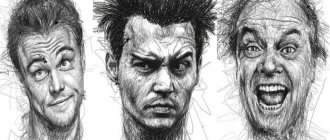Wundt's theory
Wilhelm Wundt, as the founder of structuralism, considered the structural aspect of emotions. He believed that any emotional state has a certain meaning in some dimension depending on its intensity.
His theory is also called three-dimensional, because it has three gradations: pleasure - displeasure, calm - excitement, tension - release. Some conditions involve one or two dimensions, while more complex ones involve all three. For example, consider the emotion of anger. This emotion can be represented as displeasure + excitement + tension. Thus, each emotion consists of a certain combination that can be added from the above pairs of experiences.
Features of the manifestation of emotions and feelings
Only children clearly show their emotions. Everything they encounter is immediately expressed. With age, a person has more opportunities to keep the balance of emotions under control. He does this consciously or under the influence of others.
In psychology, human emotions can be controlled as follows:
- Hold them back against your own will. At the same time, the person does not demonstrate anger and does not show love. This method may be a consequence of upbringing or serious emotional shock.
- Show feelings depending on the situation. At the same time, a person can mentally process unwanted emotions, transforming them from destructive to neutral. They can also be converted into constructive ones. This method is a consequence of working on your personality. It is considered more harmless to physical and psychological health.
A person who does not close himself off, but controls his state, and also understands the feelings and emotions of other people, is endowed with emotional intelligence. Such people do not lose their temper over little things. At the same time, they are able to support another person if he is sad or angry.
James-Lange theory
This theory is called peripheral. It was discovered by two scientists almost at the same time, which is why it received such a double name. Its essence lies in the fact that the emergence of any emotion is preceded by a physiological reaction of the body. And the cause-and-effect relationship we are accustomed to is of a slightly different order. That is, according to the theory, we feel fear because we tremble, and we do not tremble because we feel fear. And not vice versa. The mechanism for the emergence of emotion begins with a physiological reaction to an external stimulus, and only then follows a certain emotional reaction.
The nature of emotions: theories and concepts
Evolutionary theory
This theory of emotions is based on the famous concept of Charles Darwin. Gradual growth is present in everything. It is also characteristic of the nature of emotions, and not just of the animal world. According to this concept, the emergence of emotions is due to a person reaching a qualitatively different level of development. This level determines its further development. Emotions help an individual express his feelings, interact effectively with people around him, and achieve his goals. We all live in a society and in order to feel needed, we constantly need to interact with representatives of our own species. The evolutionary concept insists that human emotions developed gradually over time, from lower levels to higher ones. This theory is based on the concept that an individual's feelings develop over the years. That is, an adult is capable of experiencing a whole range of emotions of varying degrees and can recognize a wide variety of feelings in himself. Children often cannot explain to themselves what is happening to them; they do not know how to control their own emotional state and therefore find themselves driven by feelings.
Rudimentary theory
This psychological theory of emotions is also quite interesting in its own way. The rudimentary concept is aimed at analyzing feelings from the point of view of the development of social consciousness. She considers the emergence of emotions as a behavioral reaction formed under the influence of elementary instincts. Affective reactions are determined by nature and are almost impossible to control by external efforts. A rudimentary theory suggests that emotions appeared in a person under the influence of affective reactions, that is, they were inherent initially. Affective reactions, in turn, are considered as residual phenomena given to us by nature itself. They testify to the inextricable connection between man and animals. Every living creature has a whole range of reactions to certain stimuli, and people are no exception here.
Psychoanalytic theory
The psychoanalytic theory of emotions became widespread thanks to the research works of Sigmund Freud. This concept examines the phenomenon of the emergence of emotions through the prism of the psychological component. That is, a person spends a certain amount of energy to perceive information, current events or interact with different people. The psychological component here is very important, since it affects a person’s feelings, helps him understand himself and the world around him. It allows you to track people’s reactions and your own to words spoken or actions taken. Psychological theory considers emotions as an integral part of everyday life. Without emotions, a person would not be able to fully exist and develop. Only by resorting to psychoanalysis can we try to explain some of the actions of people and their individual behavioral characteristics. Analysis of feelings allows you to timely detect the pressing problem that creates difficult situations. A large role in determining the emotional component belongs to the unconscious. Sigmund Freud, speaking about the theory of the unconscious, noted the need to look beyond one’s own capabilities. In his opinion, any psychological difficulties are based on unresolved problems of the past. Only by turning to your roots can you truly overcome fears, doubts, uncertainty and other psychological difficulties. A person contains great potential, but cannot use it to the fullest due to the existence of limiting factors. What are these factors? Lack of self-confidence, fear of seeming stupid, fear of new things, other behavioral reactions.
Two-factor theory
Its founder is scientist Stanley Schechter. He developed the doctrine that human emotion has two main components, which, in fact, control the sphere of feelings: physiological arousal and cognitive interpretation. The first component, as a rule, determines the second. In other words, at first we succumb to some reaction that arises in the depths of our unconscious, and then we try to think with our heads and explain to ourselves what actually happened. With the help of the cognitive component, a person can draw specific conclusions, come to complex conclusions, and make discoveries. The psychological orientation of the theory of emotions suggests that an individual usually passes through himself all the events that happen to him. Emotional experiences have a deep meaning: they allow you to reach a completely new level of understanding the essence of things. A person cannot always consciously explain something to himself, and then a problem arises: an intrapersonal conflict begins, since feelings continue to control him.
Need-information theory
The author of this theory is the domestic scientist Pavel Vasilievich Simonov. He investigated the problem of the relationship between emotions and psychological factors and identified a close pattern between them. What is it expressed in? The fact is that every person has a need to understand the world around him, as well as to self-knowledge. The desire to possess information is determined by human nature and his individual needs. When studying something, a person experiences certain feelings, and it is they that encourage him to develop further, to learn something new. Emotions allow you to quickly and easily absorb complex information. The theory proves that if knowledge has passed through the emotional sphere, then it will not be forgotten. Everything that a person experiences through his senses remains with him.
Cognitive dissonance theory
Theories of emotion would be incomplete without this remarkable concept. Its founder is Leon Festinger. According to this concept, in everything a person does, he puts his feelings into it. Positive feelings reinforce self-confidence, and negative feelings help you achieve your goals despite current circumstances. The theory of cognitive dissonance shows that when there is some discrepancy between feelings and reality, a person tries to improve the conditions under which he could feel more comfortable. The emergence of feelings here is associated with a negative factor, although it leads to development. This theory reveals the psychological characteristics of the individual, reveals the level of his needs and reactions. Thus, when talking about theories of emotion, it is important to remember that each concept deserves respect. Every concept has its own, undeniable right to exist. The choice of a person in everyday reality is to adhere to one of the theories of the origin of emotions, while rejecting others, or to recognize the existence of all concepts at once. This is because every person has the right to his own opinion and his own reality in which he lives constantly. The psychological aspects of each concept regarding the sphere of feelings can be called correct, since they affect different components of one complex issue.
Cannon-Bard theory
American psychologists developed a thalamic theory of emotions, which was opposed to the peripheral theory. They believed that a certain emotion cannot be a consequence of the body's physical reaction to a stimulus for several reasons. The same bodily reaction can indicate different emotions, and with the same emotional state, completely different physiological manifestations can occur. Scientists have concluded that the emotional reaction appears approximately simultaneously with the physiological one. And the bodily reaction is due to the active work of the thalamus, which is located in the brain, and upon receiving a signal about an external stimulus, it triggers processes aimed at producing both a physiological and emotional reaction. Thus, the above reactions of the body proceed in parallel.
Biological theory
According to this theory, the emergence of emotions in a person is inextricably linked with his needs. Namely, with their occurrence and satisfaction. Soviet physiologist P.K. Anokhin believed that emotions were fixed as a result of evolution and separately noted the adaptive function of emotions.
With their help, the body adapts to the environment, gets used to it and becomes capable of further development and evolution. The scientist revealed that when a need is successfully satisfied, a person develops a positive emotion and thereby remembers how he should act in the future, this is how consolidation occurs. If the need is not satisfied, then the person experiences a negative emotion. Then anxiety may arise and then he has to look for other solutions to satisfy his need.
Evolutionary theory of emotions[ | ]
Charles Darwin's evolutionary theory of the origin of emotions, published in The Expression of the Emotions in Man and Animals in 1872. It applies the evolutionary principle to the psychological development of a living organism and proves that there is no impassable gap between animal and human behavior. As Darwin showed, anthropoids and children born blind have much in common in the external expression of different emotional states and in expressive bodily movements. These observations formed the basis of his theory. Emotions, according to this theory, appeared in the process of evolution of living beings as vital adaptive mechanisms that contribute to the adaptation of the organism to the conditions and situations of its life. The bodily changes that accompany various emotional states, in particular those associated with the corresponding emotions of movement, according to Darwin, are nothing more than the rudiments of real adaptive reactions of the body. And indeed, the commonality of the emotional expressions of man and, in any case, of the higher animals that stand closest to man is so obvious that it defies any dispute. [1]
Need-information theory
This theory was proposed by the domestic physiologist P.V. Simonov. In his understanding, emotions are determined by an actual need and how a person assesses the possibility of satisfying it. The evaluation process occurs automatically, a person analyzes certain information available to him in a habitual, unconscious way, and it quickly becomes clear to him what the likelihood is that his need can be satisfied.
The analysis takes into account:
- how strong and important a certain need is for a person;
- what will be required to satisfy it, that is, what efforts will need to be made;
- whether a person has enough resources to take actions to achieve a goal.
If such an involuntary assessment goes smoothly and its result is positive, emotions, as a rule, do not appear and the need is naturally satisfied. If it happens differently and, for example, a person does not have enough resources to satisfy his need, then a negative emotion arises and then he has to look for other solutions. And if the goal turns out to be easily achievable, then a positive emotion occurs.
Emotion activation theory
The basis of this theory is the Cannon-Bard thalamic theory of emotion. American scientists have found that the human body is somewhat more complex and not all processes aimed at the emergence of emotions occur exclusively from one part of the brain - the thalamus. They believed that the body's emotional reaction appears due to the coordinated functioning of the various components of the brain structures. The main role was given to the excitation of neurons in the brain stem, which send impulses to the thalamus, hypothalamus and cortex, resulting in the activation of emotions.
Two-component theory
This theory belongs to cognitive theories because it contains a cognitive aspect. According to this theory, the occurrence of emotions is associated with two components, namely two factors, which are physiological changes in the human body and their conscious interpretation. This theory includes the James-Lange peripheral theory, to which a cognitive component is added. That is, a physiological reaction occurs, then the circumstances of the situation in which it happened are analyzed, and only then the emotion is recognized. Thus, the same physiological state can be experienced in completely different ways, depending on what the person himself thinks about its causes and how he perceives it.
Criticism of this theory
This theory was criticized by W. Cannon. He argued that organic sensations are so similar to each other that it is not possible to explain with their help the whole variety of emotions experienced by a person.
In addition, he tested the thesis about organic sensations themselves as the basis of emotions. He found out that sensations in the internal organs form extremely slowly, while emotions, on the contrary, develop rapidly. W. Cannon also discovered that when organic changes are artificially induced in a person, emotional experiences do not always manifest themselves.
Moreover, an experiment was conducted that showed that the artificially induced cessation of organic signals entering the brain does not prevent the occurrence of emotions. The main provisions of the theories are presented in Figure 1.
Figure 1. “Basic provisions in the James-Lange theory and the Cannon-Bard theory”
Differential theory
American psychologist K. Izard considered emotions as a complex system. Every emotional state contains three elements:
- physiological;
- expressive;
- subjective.
Each emotional experience corresponds to a certain combination of physiological manifestations, and by observing external signs, we can judge what the people around us may be feeling. There are basic emotions that all people express in approximately the same way, although depending on their nationality, the intensity and characteristics of the expression may vary.
The scientist identified 10 fundamental emotions, and in order to show the degree of expression and intensity he indicated pairs of words as follows:
- pleasure - joy;
- astonishment;
- interest - excitement;
- anger-rage;
- contempt - disdain;
- grief - suffering;
- disgust - disgust;
- fear - horror;
- shame - shyness;
- guilt - repentance.
He also noted that a large number of emotions are presented in a mixed form, calling them dyads (for example, interest-pleasure) and triads (for example, disgust-fear-contempt).
Basic theories of emotion
Emotions are a special class of subjective psychological states that reflect, in the form of direct experiences, a person’s relationship to the world. They are included in all mental processes and human states. Any manifestations of his activity are accompanied by emotional experiences.
Classifications of emotional states.
Emotional states have very diverse manifestations. In terms of intensity and duration, they can be long-lasting but weak (sadness), or strong but short-lived (joy). According to subjective experience: emotions of a positive order, associated with the satisfaction of a person’s life needs and therefore delivering pleasure, and emotions of a negative order, associated with the dissatisfaction of life’s needs and therefore delivering displeasure.
According to the content, emotions can be classified into simple and complex, depending on what level of needs are satisfied in a person. The simpler ones include anger, fear, joy, grief, envy, jealousy, the more complex ones include moral feeling, aesthetic feeling, feeling of patriotism, etc. Finally, according to the form of occurrence, all emotional states are divided into emotional tone, mood, emotions, affect, stress , frustration, passion, higher feelings.
Affect.
In critical conditions, when the subject is unable to find a quick way out of a dangerous situation, a special type of emotional processes arises - affect. This is the most powerful emotional reaction considered . Affect is a strong and short-term emotional state, accompanied by pronounced motor manifestations and changes in the functions of internal organs. A distinctive feature of affect is the weakening of conscious control, the narrowness of consciousness. Affects, as a rule, interfere with the normal organization of behavior and its rationality. At the same time, thinking changes, a person loses the ability to foresee the results of his actions. In passion, a person seems to lose his head, his actions are unreasonable, committed without taking into account the situation. Losing power over himself, a person seems to give himself entirely to the experience.
Emotions are the immediate, temporary experience of some feeling. So, for example, the feeling of love for football is not an emotion. Emotions will be represented at the stadium by the state of admiration that a fan experiences when watching a good game of athletes or by the emotion of indignation, indignation when a game is lazy or inexperienced refereeing. The basic, fundamental emotions include pleasure, joy, suffering, surprise, disgust, anger, contempt, shame, interest, fear.
From the point of view of influence on human activity, emotions are divided into sthenic and asthenic. Sthenic (or “hypersthenic”) emotions include euphoria, mania, anger, anxiety; among the “asthenic” ones are sadness, melancholy, apathy, fear. The oldest in origin, the simplest and most common form of emotional experiences among living beings is pleasure obtained from the satisfaction of organic needs (or displeasure associated with the dissatisfaction of organic needs).
Moral (moral) are the feelings experienced by people when they perceive the phenomena of reality and compare these phenomena with the norms developed by society. Moral standards depend on traditions, customs, religion, and the dominant ideology accepted in society.
Intellectual feelings are experiences that arise in the process of human cognitive activity. Intellectual feelings include surprise, curiosity, inquisitiveness, a feeling of doubt about the correctness of a decision, etc. Success or failure, ease or difficulty of mental activity causes a whole range of experiences in a person.
Aesthetic feelings represent a person’s emotional attitude to beauty in nature, in life and in art. A person experiences aesthetic feelings when perceiving works of fiction, music, visual arts, drama and other types of art. Higher feelings represent a special form of experience . Feelings are personal formations. They characterize a person socially and psychologically. Emotions are relatively weakly manifested in external behavior, sometimes from the outside they are completely invisible to an outsider. They, accompanying one or another behavioral act, are not even always conscious, although all behavior is associated with emotions, since it is aimed at satisfying a need. A person’s feelings, on the contrary, are outwardly very noticeable.
Mood.
Submood is understood as a general emotional state that colors all human behavior over a long period of time. Mood is an emotional reaction not to immediate events, but to their meaning for a person in the context of his overall life plans. This is not a special experience timed to coincide with some particular event, but a diffuse, general state. The mood is very diverse and can be joyful or sad, cheerful or depressed, cheerful or depressed, calm or irritated, etc.
Emotional stress.
Emotional stress is a state of excessively strong and prolonged psychological stress that occurs in a person when his nervous system receives emotional overload. Emotional stress appears in situations of threat, danger, resentment, etc. Stress disorganizes a person’s activities and disrupts the normal course of his behavior.
Frustration is a psychological state of disorder, depression, caused by objectively insurmountable (or subjectively perceived) difficulties that arise on the way to achieving a goal. Frustration is accompanied by a whole range of negative emotions, anger, depression, external and internal aggression.
Love is the highest degree of emotionally positive relationship. In the development of one person’s love for another, a certain periodization is observed. Stendhal identifies four types of love: love-passion, love-attraction, physical love, love-vanity, and presents the genesis of love as follows: admiration; pleasure; hope; origin; first crystallization (active idealization of the object of love); doubt; second crystallization (2nd idealization, combined with the desire to convince oneself, to prove that the object of admiration reciprocates).
Theories of emotions. Evolutionary theory of emotions.
Darwin proved that the evolutionary principle is applicable not only to the biological, but also to the psychological and behavioral development of living things, and that there is no impassable gap between the behavior of animals and humans.
theory suggests that the body first reacts to some situation, which is then experienced by us as a certain emotion. Those. When we meet an angry dog, we first feel how our knees tremble and feel cold inside, and then we realize that we are scared. According to James, “we are sad because we cry, angry because we strike, afraid because we tremble.”
theory casts doubt on this theory, because, according to Cannon, many different emotions correspond to the same physiological states and it depends only on the individual how he interprets this state and what sign - positive or negative - he attributes to it . Wundt, based on empirical data, identified six main components of the sensory process and proposed three main dimensions of emotions: pleasure-displeasure, excitement-calm, direction-resolution, which was reflected in his three-dimensional theory of feelings.
P. Simonov's information theory establishes a relationship between the occurrence of an emotion of a certain color and severity and the degree of awareness of the individual about the possibility of satisfying any need. Emotion = information needed - information available. It is clear that if an individual has all the necessary information about the possibility of satisfying a need, then a positive emotion arises; if the available information is not enough, then a negative emotion arises.
main idea is that emotional consciousness is initially the consciousness of the world, and emotion is the transformation of the world. However, there are also false emotions, which are just forms of behavior. True emotion is accompanied by a feeling of persuasiveness. “An emotion is what one believes.” When a person finds himself in a dead end, he rushes entirely into emotion, degrading in the process. Any emotional perception occurs only against the background of a complete change in the world. Sartre calls emotion “a sudden fall of consciousness into the magical.”
Adaptation syndrome theory
The concept of adaptation syndrome was introduced by H. Selye, considering it as stress, due to which the body adapts to difficult environmental conditions.
He conducted research on animals, studying the influence of various factors on their behavior and came to the conclusion that the adaptation process includes three stages:
Alarm stage
At this stage, a person usually feels anxious and restless. And sometimes a feeling of elation, in those cases where he feels particularly confident and ready to cope with the upcoming task.
Resistance stage
The level of cortisol in the blood increases, blood pressure rises, and the heart rate increases. The body is mobilized, it is in good shape and in this state it is capable of accomplishments.
Exhaustion stage
When interaction with a stressful stimulus is prolonged and it becomes difficult for a person to resist it, internal strength and energy dries up. The work of all internal systems slows down. General health worsens. And if the body becomes too weak, a person can become very seriously ill.
Cognitive dissonance theory
L. Festinger proposed this theory based on studying a person’s perception of his expectations and reality, as well as how they relate to each other. He argued that if a person’s expectations are fully realized, the individual remains satisfied and then positive emotions arise. If reality does not meet his expectations, an uncomfortable state and negative emotions arise. In this case, a person begins to look for another way out, and there are two possible options. Either a person changes the cognitive aspect of the current situation, that is, he changes his expectations and attitude towards reality so that the negative emotion is leveled, or he looks for a way to change the undesirable result that he observes in reality and does not agree with.
Two-factor theory of emotions[ | ]
Main article: Two-factor theory of emotion
Stanley Schechter's two-factor theory of emotion suggests viewing emotion as a combination of two components: physiological arousal and the cognitive interpretation of this arousal. According to the theory, "the products of the cognitive process are used to interpret the meaning of physiological responses to external events." The following experiment illustrates this theory: “Four groups of students took an exam. Previously, an experiment was conducted with these students, in which two groups were examined under conditions of hostility, and the other two - under conditions of a friendly attitude. During the exam, one of each pair of groups received an injection of adrenaline, and the other received a control injection of saline. The students reported their experiences. As expected, the first group experienced predominantly negative emotions, while the second group experienced predominantly positive emotions. The effect of adrenaline was unexpected. It enhanced both positive and negative emotions. Whatever physiological state the injection caused, its sign was determined by the setting - the social environment of the students, and not by the injected substance."[6] Emotion, on the one hand, determines the energetic component of consciousness, and on the other, its quality is determined by the interaction of the content of consciousness and a possible program of action. The two-factor theory indirectly separates the problem of the strength and sign of an emotion from its qualitative content. Actually, many researchers point to the energetic component of emotions, but the mechanism of its implementation in the system of other mental phenomena remains unclear. For example, we find the idea about the level of brain excitability as a modifier of animal behavior in Leonid Viktorovich Krushinsky. This hypothesis was based on experiments in which artificially increasing the excitability of the nervous system of cowardly and vicious dogs by introducing pharmacological agents led to a significant increase in active and passive defensive reactions.[7]
Facial feedback theory
S. Tomkins developed the theory of facial feedback based on the scientific research of W. James. According to this theory, every emotion is automatically reflected in a certain way on a person’s face. Thus, when exposed to a stimulus, a physiological reaction occurs and those facial muscles that correspond to the experienced emotion are tensed. As in the peripheral theory of emotions, the bodily reaction here is primary and one can judge the emotion that has arisen by facial expression. That is, for example, if a girl smiles, then she is happy and joyful, and if she frowns, then she probably experiences sadness or another negative emotion. Thus, changes in the facial muscles give the brain a kind of hint about what emotion is taking place. Various experiments were carried out, on the basis of which it was revealed that when reacting to the same stimuli, most people experience similar facial expressions.
Psychophysiology of emotions
Psychophysiology studies the physiological foundations of human mental activity and behavior. It intertwines two sciences: psychology and physiology. Some scientists believed that the activity of the human brain and nervous system should be considered separately from the psyche and not take into account the possibility of its influence on physiology. They saw the goal of psychophysiological research as identifying the parallelism of physiological and mental processes.
The psychophysiology of emotions indicates that the human psyche and brain are much more closely interconnected than it might seem at first glance. Thus, by influencing the brain, one can observe obvious mental changes, and by influencing the human psyche, one can achieve sustainable changes in brain activity, which will be reflected in the external behavior of a person.
Theories of emotions in psychology are very diverse and each of them has a reasonable grain. But any theory acquires true meaning if it is applied in practice. And theories of emotions are no exception. For example, on the basis of the James-Lange peripheral theory of emotions, a device such as a polygraph, or in other words, a lie detector, was developed.
And Paul Ekman proposed a special technique on how to determine by facial expression what a person is hiding, and how to skillfully recognize even the most subtle manipulation and lies. Based on his developments, a series was also filmed called “The Theory of Lies” or “Lie to Me.”
Thus, when analyzing various theories of emotions in psychology, you should first of all pay attention to how you compare their aspects with your life situations and when interacting with people. It is also important what exactly of the learned theories resonates. Perhaps you want to better identify a person's emotional state or be more aware of what feelings arise in you and for what reasons. Using knowledge about emotions in practice, you will soon notice that it becomes easier to understand yourself and the people around you.
Origin of emotions
A reflex is a specific reaction to a specific stimulus. Instincts ensure the successful execution of more complex behavior patterns, and some of these patterns remain unchanged throughout the animal's life from birth to death.
We know that a person is born with a very limited set of reflexes, and only a few of them, like the blink reflex, remain with him forever. Reflexes and instincts are rigid, they are rigidly tied to the stimulus, they are clearly not enough when the situation requires making a decision in a situation of choice or in a situation requiring flexibility of behavior. However, reflexes and instincts ensure the adaptation of the individual, providing him with a clearly defined way of responding to a limited, constant set of objects and environmental phenomena. The same can be said about the motives we call drives - hunger, thirst, sexual desire, avoidance of pain and the need to eliminate waste products from the body. These motivational systems are essential for human survival. These are sometimes called survival needs because they, along with the regulatory chemical, or homeostatic, system ensure our physical well-being.
But how and why did emotions arise? As our ancestors evolved, the period of growing up and training of young individuals became longer and longer; they needed more and more time to learn how to get food and take care of themselves. In order for a child to survive, a close mutual attachment had to develop between him and the person who cared for him (usually the mother). We do not know how it arose and how it was transformed during evolution, but, based on modern research data, we can confidently say that emotions are the cementing factor in the mutual attachment of mother and child. A simple experiment can provide clear proof of this. Leave a one-year-old baby without a mother in an unfamiliar room for a few minutes. Most children will react to separation with intense emotion (Ainswortli, Blehar, Waters, Wall, 1978; Shiller, Lzard, Hembree, 1986). If the connection between mother and baby is disrupted for a longer period of time or is disrupted permanently, we can observe an expressive bouquet of negative emotions, which in some cases develop into severe forms of depression and can even cause general exhaustion of the body (Bowlby, 1969; Spitz, 1965).
Undoubtedly, one of the reasons for the emergence of human emotions during evolution was the need to ensure a social connection between mother and child. The ecological niche of the human child is such that the bearer of all the cognitive, social and physiological skills necessary for the survival of the infant is the adult who cares for him. The baby simply would not have survived if his mother had not felt a powerful need to hold him in her arms. The child depends on the mother in everything: she satisfies his needs for food, warmth, care, and protects him from danger. Not so long ago we realized that, in addition to all this, a child also needs parental love for physical health and psychological well-being. Even an adult can find it difficult to cope with life's troubles if he is deprived of love. It is this kind of deprivation that underlies many psychological disorders, and especially depression. (In the last chapter we will return to this issue and consider what influence the duration of the period of childhood dependence and the mutual attachment of mother and child have on the emergence and formation of a complex emotional complex called love.)
Another reason for the emergence of emotions was the urgent need for means of communication between mother and child, as well as between adults. Numerous studies devoted to the emotional development of a child show that long before a child begins to understand speech addressed to him and pronounce individual words, he can already communicate to others about his internal state using a certain set of signals (lzard, Huebner, Risser, McGinnes and Dougherty, 1980). For example, hunger and pain can manifest themselves through the outward expression of physical suffering. Involvement in a situation, interest in a person or object is signaled by the child's expression of joy and interest, while frustration is expressed by anger (Figure 1-1).
Such a system of social communication, based on emotional expression, is vitally important, because without it the connection between mother and child would be impossible. Research shows that parents whose children suffer from Down syndrome are very upset and depressed by the fact that their children cannot communicate their experiences to them through facial expressions and other means of emotional communication (En-ide, Katz, Thorpe, 1978).
Emotions are essential for human survival and well-being. Without emotions, that is, without the ability to experience joy and sadness, anger and guilt, we would not be fully human. Emotions have become one of the signs of humanity. Equally important is our ability to empathize with other people’s emotions, the ability to empathize, as well as the ability to express an emotion in words and talk about it. The evolutionary significance of emotions is that they provided a new type of motivation, new behavioral tendencies, and greater variability in behavior necessary for the individual’s successful interaction with the environment and for successful adaptation.
Izard K.E. Psychology of emotions / Transl. from English - St. Petersburg, 1999. - 464 p.









